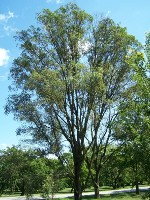Mon-Fri 9am - 5pm Mountain time
Siberian Elm vs Wayfaring Tree
Ulmus pumila
Viburnum lantana
PRODUCTION CANCELLED
CUSTOM GROW
Siberian Elm is a small to medium-sized deciduous tree. It has a similar form to American Elm, but smaller, with a more pyramidal habit and shorter lifespan. It is also more resistant to Dutch Elm disease and is very salt tolerant.
Siberian Elm was grown as shelterbelts in the prairies after the Dustbowl disasters, where its rapid growth and tolerance for drought and cold initially made it a great success. It is an excellent shade tree.
Note: Due to it's increasingly controversial reputation for being invasive in warmer climates, we are no longer planning to grow this species for retail purchase on a regular basis.
Wayfaring Tree is an adaptable and reliable shrub. It is prized for its ornamental berries that can range in color from red to yellow to black. Consider getting two trees as fruiting is maximized when another Wayfaring Tree is present.
This species has a variety of uses ranging from naturalization, mass planting, borders, and privacy screens.
Siberian Elm Quick Facts
Wayfaring Tree Quick Facts
In row spacing: 2.4 - 3 m (8 - 10 ft)

